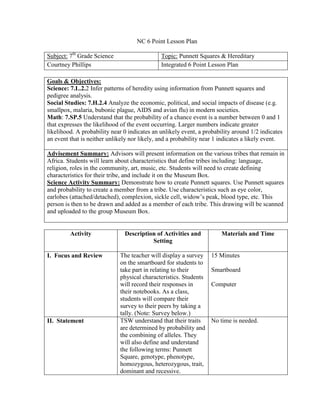
Lesson plancourt
- 1. NC 6 Point Lesson Plan Subject: 7th Grade Science Topic: Punnett Squares & Hereditary Courtney Phillips Integrated 6 Point Lesson Plan Goals & Objectives: Science: 7.L.2.2 Infer patterns of heredity using information from Punnett squares and pedigree analysis. Social Studies: 7.H.2.4 Analyze the economic, political, and social impacts of disease (e.g. smallpox, malaria, bubonic plague, AIDS and avian flu) in modern societies. Math: 7.SP.5 Understand that the probability of a chance event is a number between 0 and 1 that expresses the likelihood of the event occurring. Larger numbers indicate greater likelihood. A probability near 0 indicates an unlikely event, a probability around 1/2 indicates an event that is neither unlikely nor likely, and a probability near 1 indicates a likely event. Advisement Summary: Advisors will present information on the various tribes that remain in Africa. Students will learn about characteristics that define tribes including: language, religion, roles in the community, art, music, etc. Students will need to create defining characteristics for their tribe, and include it on the Museum Box. Science Activity Summary: Demonstrate how to create Punnett squares. Use Punnett squares and probability to create a member from a tribe. Use characteristics such as eye color, earlobes (attached/detached), complexion, sickle cell, widow’s peak, blood type, etc. This person is then to be drawn and added as a member of each tribe. This drawing will be scanned and uploaded to the group Museum Box. Activity Description of Activities and Materials and Time Setting I. Focus and Review The teacher will display a survey 15 Minutes on the smartboard for students to take part in relating to their Smartboard physical characteristics. Students will record their responses in Computer their notebooks. As a class, students will compare their survey to their peers by taking a tally. (Note: Survey below.) II. Statement TSW understand that their traits No time is needed. are determined by probability and the combining of alleles. They will also define and understand the following terms: Punnett Square, genotype, phenotype, homozygous, heterozygous, trait, dominant and recessive.
- 2. III. Teacher Input TTW relate Wednesday’s 55 Minutes introduction to Punnett Squares IV. Guided Practice to the activity students will be Key of Alleles Poster taking part in today. Each student (Displayed in front of V. Independent Practice will be paired with a classmate of classroom) the opposite sex and will be defined as parents. First, the pair Trait Sheet for Each Student will flip a coin to determine the sex of their offspring. One Dice, Coin, Small (Heads=Girl, Tails=Boy) Poster Board and Pack of TTW provide each parent a Trait Coloring Pencils for Each Sheet (Note: Trait Sheet example Pair of Students below.) describing their specific characteristics and alleles. With One Birth Certificate for each trait, TSW construct a Each Pair of Students Punnett Square with each parent’s alleles to determine the possible outcomes of their offspring. If there are four possible outcomes for each trait, TSW roll a dice to land on a number (1-4). This number represents a possible outcome on the Punnett Square, which is now also their child. However, if there are sixteen possible outcomes, TSW roll the dice 2 times. The first roll represents the column their child is located. The second roll represents the row their child is located in. The trait assigned to their offspring will be determined by the number rolled. Example—16 Outcomes: Roll #1: 3 Roll #2: 1 X Example—4 Outcomes: Roll #1: 4 Child 1 Child 2 Child 3 Child 4
- 3. Note: The dice may land on 5 or 6. If so, reroll until the dice lands on a number between 1 and 4. After each couple has filled out a Birth Certificate, (Note: Birth Certificate below.) they will be required to draw their child. VI. Closure TOTD: After students have 20 Minutes created their child, their drawing will be presented in front of their No additional materials are classmates. Students will be needed. asked to describe their drawing to their peers, sharing their outcome from each trait. At the end of the period, students will turn in their drawing, birth certificate and Punnett Squares work. See Below Pages (I have created each of the documents below.)
- 4. “Where’d you get those genes?” Survey 1. What is your eye color? ___Blue ___Brown ___Green ___Hazel 2. Do you have freckles ___Yes ___No 3. Can you roll your tongue? ___Yes ___No 4. Do you have dimples on your cheeks? ___Yes ___No 5. Are your earlobes attached or detached? ___Attached ___Detached 6. Do you have a widow’s peak? ___Yes ___No 7. Do you have a cleft chin? ___Yes ___No 8. What color is your hair? ___Black ___Brown ___Blonde ___Red 9. What is the texture of your hair? ___Curly ___Wavy ___Straight
- 5. Trait Sheet Example (Mother) Eye Color: Bb-Brown Lips: bb-Thin Freckles: FF-Freckles Earlobes: Ee-Unattached Dimples: dd-No Dimples Skin Color: aabb-Light Eyelash Length: ll-Short Hairline: Ww-Widow’s Peak Nose Shape: bb-Straight Nose Width: BB-Broad Hair Texture: Cc-Curly Hair Fullness: Ff-Full Hair Color: Dd-Dark Color Face Shape: Rr-Round Eyebrows: Bb-Bushy Uni-brow: Nn-Not Present Eye Separation: EE-Wide Separation Eye Angle: Hh-Horizontal Hair in Ears: hh-Present
- 6. Birth Certificate Student 1 & Student 2 announce the birth of their Son/Daughter, Student Chooses Name. This child belongs to the tribe Student Chooses Tribe. The Child’s Traits are Listed Below: Eye Color: Lips: Freckles: Earlobes: Dimples: Skin Color: Eyelash Length: Hairline: Nose Shape: Nose Width: Hair Texture: Hair Fullness: Hair Color: Face Shape: Eyebrows: Uni-brow: Eye Separation: Eye Angle:
